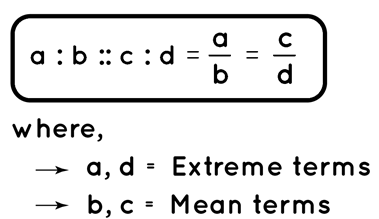About Proportion Formula
Let us first review the concept of proportion before moving on to the proportion formula. Two ratios are said to be in proportion if they are equal. If the four elements a, b, c, and d are in proportion, then a/b = c/d. Extremes a and d are known as extreme terms, while mean terms b and c are known as mean terms. The product of means equals product of extremes in the ratio. If the cross-products of two ratios are equal, they are said to be equivalent
When two ratios are equal, they are in proportion, according to the definition of proportion. When two ratios or fractions are equivalent, the proportion formula is employed. The percentage formula is as follows:
a/b = c/d = a : b :: c : d

Proportion Formula
c : d :: a : b = c/d = a/b
- a, d - Extreme terms
- b, c - Mean terms
product of means = product of extremes is another formula linked to proportion. This is expressed as ad = bc.
Two alternative proportional formulas based on direct or indirect variation are available. When two quantities x and y have a direct proportion, y = kx, and when they have an indirect proportion, y = k/x, where k is the proportionality constant.